
Blog about all things SAP
ERProof » SAP CO » SAP CO Training » SAP CO Account Assignment

SAP CO Account Assignment

Normally, when a financial document is entered in SAP FI module , user has the option of entering the cost center in the financial document. However, when documents are entered from different modules or a cross-module financial transaction occurs, such as from MM or SD , there is no option of entering the cost center in the document. In this situation, the SAP system will derive the cost center through automatic SAP CO account assignment, substitutions, or through default settings made in the primary cost element.
Automatic SAP CO Account Assignment
The automatic account assignment has to be configured in the transaction code OKB9 . For posting made in external accounting, such as for price differences, exchange rate differences, etc., the SAP system automatically checks entries in the OKB9 settings and derives the cost center.
If you do not enter a CO object (order, cost center, or project) in external accounting postings made in FI, MM or SD modules and the posting is cost relevant, then the automatic account assignment checks the relevant cost center and makes the posting.
Here are examples of automatic account assignments:
- Banking fees, exchange rate differences and discounts in FI
- Minor differences and price differences in MM
The account assignment objects that can be maintained in the transaction OKB9 are:
- Cost center
- Profit center (profitability segment)
Normally, the automatic account assignment runs on the company code level along with the CO object. However, if the user wants to make the posting on the business area level, valuation area level or profit center level, it is also available in OKB9 settings. So basically it includes the following levels:
- Company code level
- Business area level
- Valuation area level
- Profit center level
The above 3 excluding the company code level are used in cases when the account assignment is needed below the company code level.
Prerequisites
Here are the prerequisites of activating automatic SAP CO account assignment:
- Activation of the cost center accounting
- Creation of cost centers
- Maintenance of cost elements
Additionally, you can also create orders and profit centers as per the business requirements.
Settings in Transaction OKB9
Let’s discuss settings that are possible for automatic SAP CO account assignment in OKB9 transaction.
Start SPRO transaction and navigate to the following path:
Controlling – Cost Center Accounting – Actual Postings – Manual Actual Postings – Edit Automatic Account Assignment (OKB9)
Alternatively, you can start OKB9 transaction directly from the command bar.
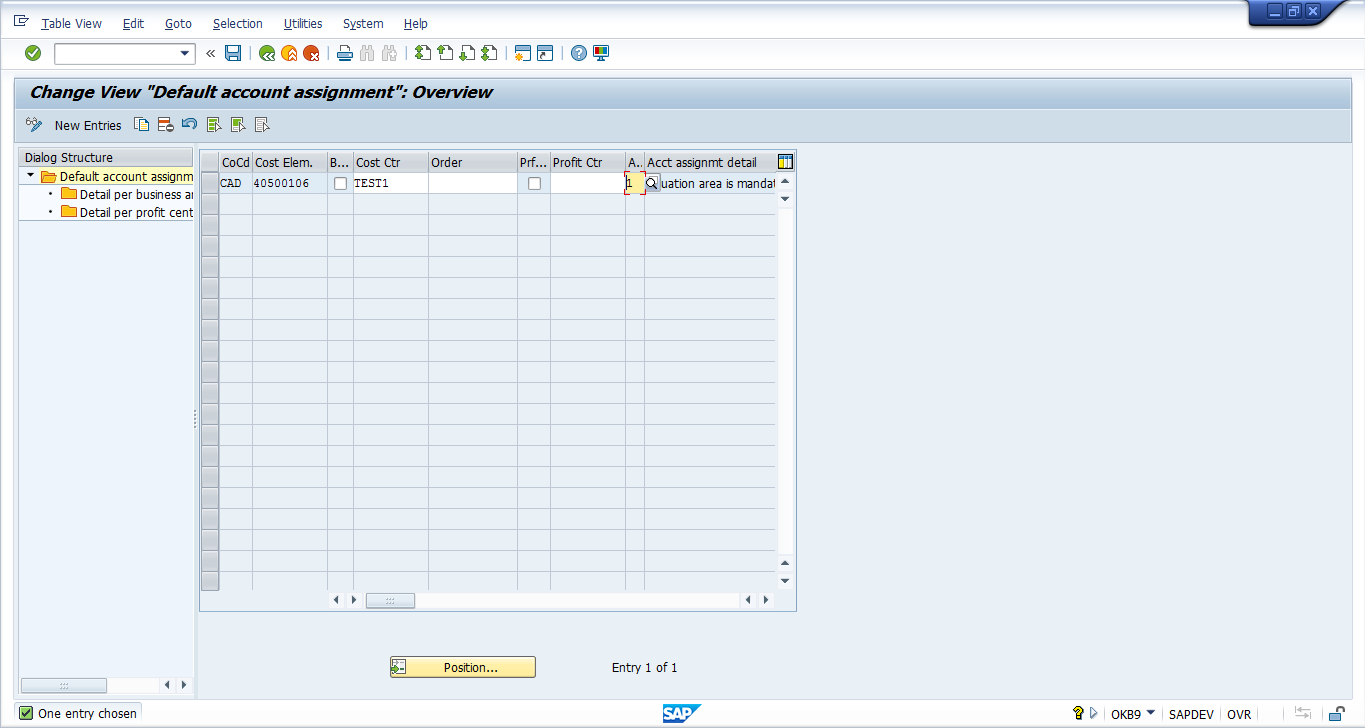
- If you want to have the setting on the company code level only, then enter the company code and the cost element along with the corresponding CO object, i.e. a cost center, an order or a profit center.
- If you want to have the settings on the valuation area level, then enter the company code and the cost element and chose the ‘valuation area’ option in the account assignment detail as ‘1’.
- Similarly, if you want to have the settings on the business area or profit center level, then choose the option ‘2’ or ‘3’ respectively.
If you have chosen account assignment detail ‘1’ or ‘2’, then click on ‘Detail per business area/valuation area’ on the left sidebar.
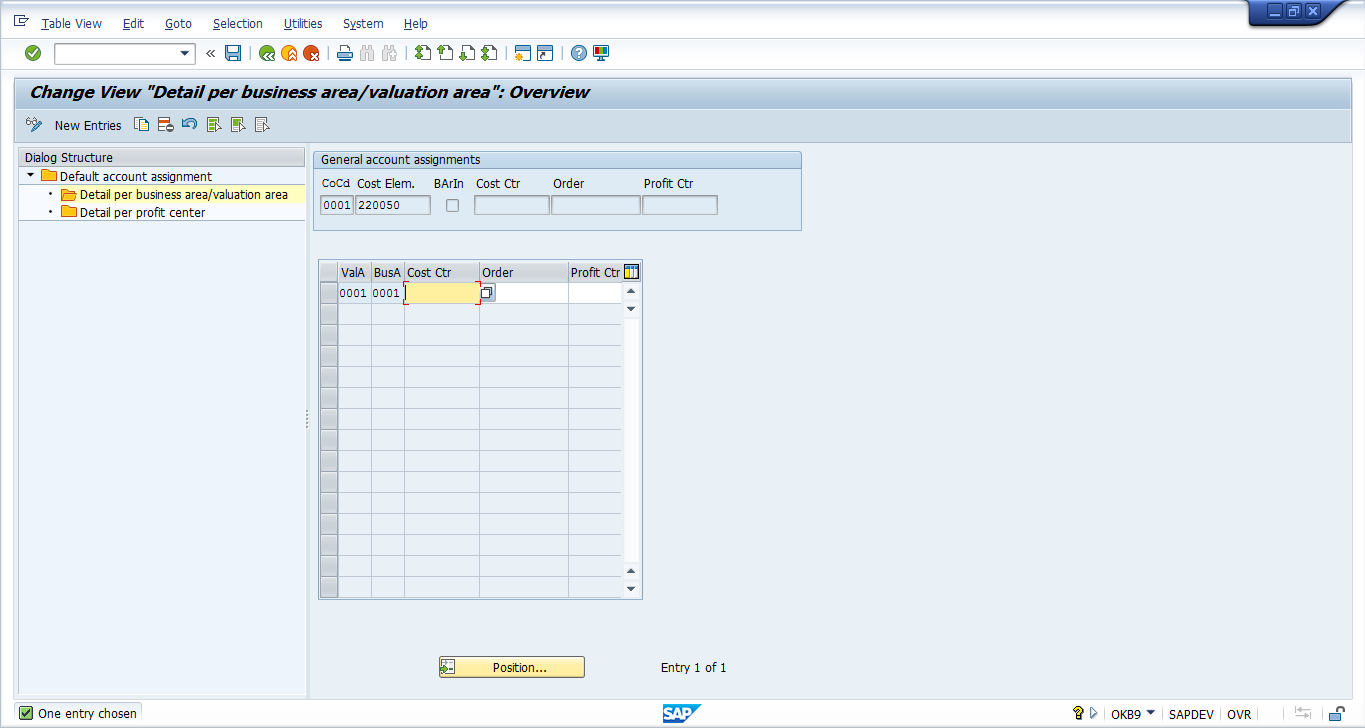
Default SAP CO Account Assignment
In order to determine the correct CO account assignment, the SAP system performs several checks in the following sequence. First it checks the document which a user is posting. If the cost center is empty in the document, then the system checks if any substitutions are maintained for the particular G/L account . Next, if the substitution is also missing, then the system moves on to the OKB9 settings for automatic SAP CO account assignments. Finally, if these settings are also missing, the SAP system checks master data of the primary cost element (G/L Account) under the tab of Default Account Assignment . You can display this master data using the transaction KA03 .
You can maintain the cost center and the order in the master data of the primary cost element.

So, basically the order of checks the system makes is:
- Financial document – Cost center
- Substitutions – transaction OKC9
- Automatic account assignments – transaction OKB9
- Default account assignments – transaction KA03 / KA02
Lastly, if any of the above is not maintained, then the SAP system throws an error ‘Account X requires an assignment to a CO Object’ and doesn’t allow posting of a document.
SAP CO Account Assignment using Substitution
In cases where you don’t need OKB9 or default account assignment, the user can go for user exits where a specific G/L account is mentioned under the company and the value in the cost center is substituted by the cost center given in the substitution.
The transaction for maintaining the substitution is GGB1 .

Usage of substitutions for SAP CO account assignment is justified by the business requirement and usually SAP CO account assignment requirements are fulfilled by OKB9 or default account assignments.
Did you like this tutorial? Have any questions or comments? We would love to hear your feedback in the comments section below. It’d be a big help for us, and hopefully it’s something we can address for you in improvement of our free SAP CO tutorials.
Navigation Links
Go to next lesson: SAP Adjustment Postings
Go to previous lesson: SAP Profit Center
Go to overview of the course: Free SAP CO Training
4 thoughts on “SAP CO Account Assignment”
it is helpful material i ask for more clear details for using substitution method for Account Assignment. thanks in advance
Sir, I am not receiving the training mails from yesterday 7/1/2019. I have completed my training till here(SAP CO Account Assignment) please do send the rest of the training emails for SAP CO. Hope you will do the needful.
I am getting the same error “Account 500911 requires an assignment to a CO object”. In OKB9, we have given company code, Cost element and ticked the check box ‘Indicator: Find profitability segment using substitution’ (V_TKA3A-BSSUBST) and not filled anything like cost center, order and profit center. in OKC9 we have created substitution. All the process happening through Idoc Message Type SINGLESETTRQS_CREATE and inside BAPI BAPI_SINGLESETTREQS_CREATEMULT triggering and raising this error. Cost center is not maintained in 1. Financial document – Cost center 2. Automatic account assignments – transaction OKB9 and 3. Default account assignments – transaction KA03/KA02 But we have substitution in transaction OKC9 to determine cost centre.
Where woulbe be the issue?
good explanation
Leave a Reply Cancel reply
Do you have a question and want it to be answered ASAP? Post it on our FORUM here --> SAP FORUM !
Your email address will not be published. Required fields are marked *
Save my name, email, and website in this browser for the next time I comment.

In this topic, we described about the Assign Company Code to Controlling Area with detailed example.
After Controlling Area created successfully, the company codes should be assigned to controlling area. The company codes should have the same Fiscal Year variant and Chart of Accounts which are used while creating Controlling Area.
The assigning company codes number (either one or multiple) is based on the input selection for CoCd->CO Area entry while creating Controlling Area.If the option selected “Cross-company-code cost Accounting” selected, then more than one company code should be assigned to controlling area.
Otherwise, it accepts only one company code. Below process is the assignment of company codes (TR01, TR02, TR03) to controlling area TCCA (Test Controlling Area).
Step-1: Enter the transaction code OX19 in the SAP command field and click Enter to continue.

Enter the transaction code SPRO in the SAP command field and click Enter to continue.

Click on SAP Reference IMG .

Expand SAP Customizing Implementation Guide → Enterprise Structure → Assignment → Controlling → Assign Company Code to Controlling Area . Click on Execute .

Step-2: - Select the Controlling Area , double click on it to open the controlling area details.

Step-3: - Double click on Assignment of Company Code(s) to proceed further.

Step-4: - In the next screen, Click on New Entries .

Step-5: - In the next screen, Enter the company code(s) based on the CoCd->CO Area entry.

Step-6: Click on Save button to save the changes.

Step-7: It prompt for the Change Request. Create/Select the change request and Click on right mark to proceed.

Step-8: Status bar displays the below message once the Controlling area created successfully.

Technical details: -
- Transaction: OX19
- Menu Path: SPRO → SAP Reference IMG → SAP Customizing Implementation Guide → Enterprise Structure → Assignment → Controlling → Assign Company Code to Controlling Area
- Database Table: TKA02
TutorialKart
- SAP CO Tutorial
- Basic SAP CO Settings
- Maintain controlling area
- Assign Company code to controlling area
- Define number range interval for SAP co documents
- Maintain Versions
- SAP CO Cost Center Accounting
- What is SAP Cost center accounting
- Create Cost center
- What is cost element accounting
- Create primart cost elements
- Create cost element group
- Create secondary cost elements in SAP
- Activate cost center accounting
- Define cost center categories
- Define cost center standard hierarchy
- SAP CO Profit Center Accounting
- Create dummy profit center
- Define profit center group
- Maintain Profit center standard hierarchy
- SAP CO TCodes
How to Assign Company Code to Controlling area in SAP
How to assign company code to controlling area in sap.
After configuration of controlling area in SAP , it is mandatory to assign company code to controlling area in SAP. If the company code is not assigned to controlling area in SAP, you will get an error when you are maintaining other configuration steps like creation of cost center.
Configuration steps
Step 1: Execute transaction code “ OX19 ” in the SAP command field.

Step 2: In next screen, change view basic data overview, choose position option and enter the required controlling area key and press enter to continue.
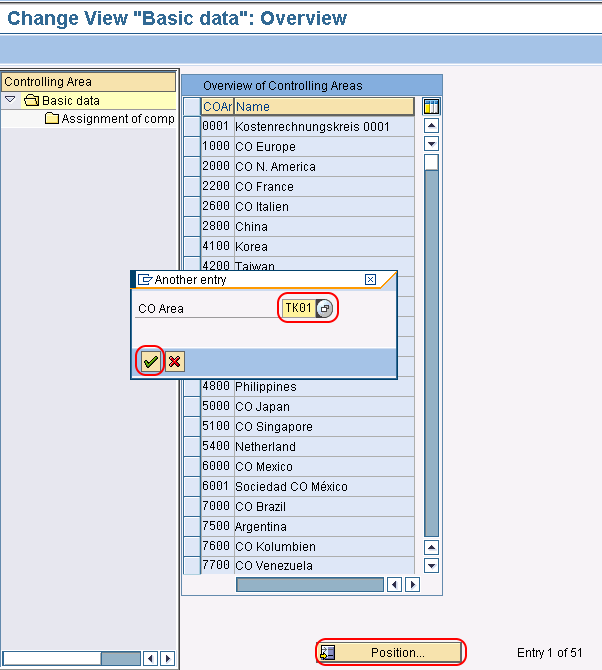
Step 3: Choose the company code and click on assignment of company codes for assignment of controlling area to company code in SAP.
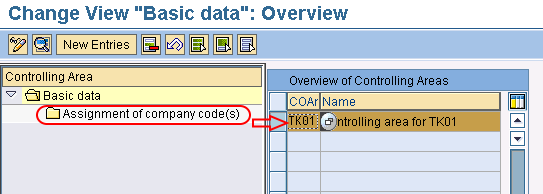
Step 4: In next screen, change view assignment of company code overview, click on new entries option.
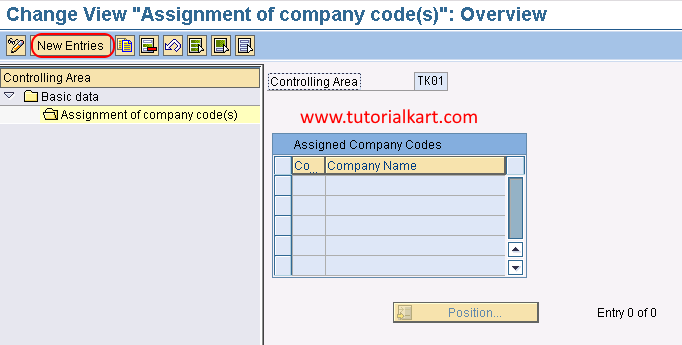
Step 5: In next screen, overview of added entries, enter the company code key in the field CoCd and press enter.
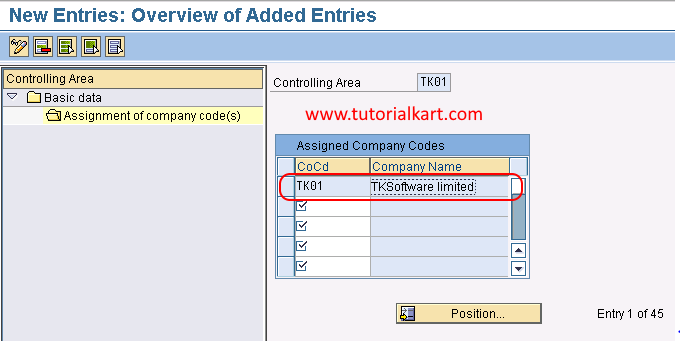
Choose save icon and save the configured assignment details.
Successfully we have assigned company code to controlling area in SAP system.
Popular Courses
- Salesforce Admin
- Salesforce Developer
- Visualforce
- Informatica
SAP Resources
- Kafka Tutorial
- Spark Tutorial
- Tomcat Tutorial
- Python Tkinter
Programming
- Julia Tutorial
- MongoDB Tutorial
- PostgreSQL Tutorial
- Android Compose
- Flutter Tutorial
- Kotlin Android
- Bash Script
Web & Server
- Selenium Java
- Definitions
- General Knowledge

Don’t Confuse Change of Control and Assignment Terms
- David Tollen
- September 11, 2020
An assignment clause governs whether and when a party can transfer the contract to someone else. Often, it covers what happens in a change of control: whether a party can assign the contract to its buyer if it gets merged into a company or completely bought out. But that doesn’t make it a change of control clause. Change of control terms don’t address assignment. They say whether a party can terminate if the other party goes through a merger or other change of control. And they sometimes address other change of control consequences.
Don’t confuse the two. In a contract about software or other IT, you should think through the issues raised by each. (Also, don’t confuse assignment of contracts with assignment of IP .)
Here’s an assignment clause:
Assignment. Neither party may assign this Agreement or any of its rights or obligations hereunder without the other’s express written consent, except that either party may assign this Agreement to the surviving party in a merger of that party into another entity or in an acquisition of all or substantially all its assets. No assignment becomes effective unless and until the assignee agrees in writing to be bound by all the assigning party’s obligations in this Agreement. Except to the extent forbidden in this Section __, this Agreement will be binding upon and inure to the benefit of the parties’ respective successors and assigns.
As you can see, that clause says no assignment is allowed, with one exception:
- Assignment to Surviving Entity in M&A: Under the clause above, a party can assign the contract to its buyer — the “surviving entity” — if it gets merged into another company or otherwise bought — in other words, if it ceases to exist through an M&A deal (or becomes an irrelevant shell company).
Consider the following additional issues for assignment clauses:
- Assignment to Affiliates: Can a party assign the contract to its sister companies, parents, and/or subs — a.k.a. its “Affiliates”?
- Assignment to Divested Entities: If a party spins off its key department or other business unit involved in the contract, can it assign the contract to that spun-off company — a.k.a. the “divested entity”? That’s particularly important in technology outsourcing deals and similar contracts. They often leave a customer department highly dependent on the provider’s services. If the customer can’t assign the contract to the divested entity, the spin-off won’t work; the new/divested company won’t be viable.
- Assignment to Competitors: If a party does get any assignment rights, can it assign to the other party’s competitors ? (If so, you’ve got to define “Competitor,” since the word alone can refer to almost any company.)
- All Assignments or None: The contract should usually say something about assignments. Otherwise, the law might allow all assignments. (Check your jurisdiction.) If so, your contracting partner could assign your agreement to someone totally unacceptable. (Most likely, though, your contracting partner would remain liable.) If none of the assignments suggested above fits, forbid all assignments.
Change of Control
Here’s a change of control clause:
Change of Control. If a party undergoes a Change of Control, the other party may terminate this Agreement on 30 days’ written notice. (“Change of Control” means a transaction or series of transactions by which more than 50% of the outstanding shares of the target company or beneficial ownership thereof are acquired within a 1-year period, other than by a person or entity that owned or had beneficial ownership of more than 50% of such outstanding shares before the close of such transactions(s).)

- Termination on Change of Control: A party can terminate if controlling ownership of the other party changes hands.
Change of control and assignment terms actually address opposite ownership changes. If an assignment clause addresses change of control, it says what happens if a party goes through an M&A deal and no longer exists (or becomes a shell company). A change of control clause, on the other hand, matters when the party subject to M&A does still exist . That party just has new owners (shareholders, etc.).
Consider the following additional issues for change of control clauses:
- Smaller Change of Ownership: The clause above defines “Change of Control” as any 50%-plus ownership shift. Does that set the bar too high? Should a 25% change authorize termination by the other party, or even less? In public companies and some private ones, new bosses can take control by acquiring far less than half the stock.
- No Right to Terminate: Should a change of control give any right to terminate, and if so, why? (Keep in mind, all that’s changed is the party’s owners — possibly irrelevant shareholders.)
- Divested Entity Rights: What if, again, a party spins off the department or business until involved in the deal? If that party can’t assign the contract to the divested entity, per the above, can it at least “sublicense” its rights to products or service, if it’s the customer? Or can it subcontract its performance obligations to the divested entity, if it’s the provider? Or maybe the contract should require that the other party sign an identical contract with the divested entity, at least for a short term.
Some of this text comes from the 3rd edition of The Tech Contracts Handbook , available to order (and review) from Amazon here , or purchase directly from its publisher, the American Bar Association, here.
Want to do tech contracts better, faster, and with more confidence? Check out our training offerings here: https://www.techcontracts.com/training/ . Tech Contracts Academy has options to fit every need and schedule: Comprehensive Tech Contracts M aster Classes™ (four on-line classes, two hours each), topical webinars (typically about an hour), customized in-house training (for just your team). David Tollen is the founder of Tech Contracts Academy and our primary trainer. An attorney and also the founder of Sycamore Legal, P.C. , a boutique IT, IP, and privacy law firm in the San Francisco Bay Area, he also serves as an expert witness in litigation about software licenses, cloud computing agreements, and other IT contracts.
© 2020, 2022 by Tech Contracts Academy, LLC. All rights reserved.
Thank you to Pixabay.com for great, free stock images!
Related Posts
Contracting with people we don’t trust.
This week’s musings on tech contracts… Mistrust has reached levels rarely seen in American politics. Yet leaders on each side will have to work together
Two NEW On-Demand Programs from Tech Contracts Academy
We’re pleased to announce two new recorded focused topic programs are available on-demand now from Tech Contracts Academy. See below for details and a sample chapter of
Don’t define a contracting party as “Acme Co. and its Affiliates”
This week’s musings on tech contracts… This week’s musing addresses a simple point. We define a contracting party as multiple entities. Don’t even do it if you
The NIST Generative Artificial Intelligence Profile: a useful issue-spotter for contracts
This week’s musings on tech contracts Most of us know that generative artificial intelligence creates some unusual risks. Few of us, however, have taken the

Our website uses cookies. If you click “Deny” or don’t respond, our system will ask your browser not to accept tracking or statistics-collecting cookies from our site, but not functional cookies. You may still receive script other technologies that Google Analytics or our other vendors use for anonymous tracking and statistics collection. For further information, please see our Cookie Policy per the link below.
Co-op vs. Internship: Know the Differences
Common differences include their duration, compensation and developed partnerships between colleges and employers.

Co-op vs. Internship

Getty Images
Students can use this time to see if a specific field is right for them and gain valuable career skills in the process.
The words "co-op" and " internship " are sometimes used interchangeably, as both are hands-on work experiences that students may complete in college . However, there are major differences between these two work-based learning opportunities.
Some colleges require all students or just specific majors to complete an internship or co-op before graduation. And even if there's not a requirement, experts advise students to still seek out these opportunities with help from career services at their school.
"My advice is, regardless if it's required for your degree program, it doesn't matter," says Maria Richart, director of career services and cooperative education at Rochester Institute of Technology in New York. "You could be a journalism student or a biology student. Do something that will expose you to the potential field that you are interested in going in."
Here's what students should know about co-ops and internships.
Differences Between Co-ops and Internships
Definitions of a co-op and internship may vary per school, but the most common distinctions include duration, compensation and designated school-employer partnerships.
Internships can be part time or full time and typically take place in the summer, lasting around 10 to 12 weeks. However, some occur in the fall or spring semesters, while students take classes simultaneously. Students may participate in several internships while in college, giving them an opportunity to try various roles.
"The difference between, say, three internships versus two internships is negligible," says Ryan Willerton, associate vice president for career and professional development at the University of Notre Dame in Indiana. "So, what you may hear students talking about amongst themselves is, 'Oh, I have to have a summer internship every summer. I need an internship after freshman year.' You do not."
Instead, he says, "what you do need to do is have some kind of experience, and that could be a landscape job. It could be taking the initiative to learn a new skill. It could be taking the entire summer to just network with people. Service work is something that we push students to consider doing. Just giving back to the community and finding a deeper purpose. It doesn't have to be, 'I need to work in a Fortune 100 company with a top-of-the-line tech internship.' You don't need that after freshman year. If you want to pursue that after junior or senior year, you certainly can."
Co-ops, on the other hand, are ongoing work experiences and range from three to 12 months of full-time work. Universities with required co-op programs usually expect students to complete at least two – sometimes three – such practical learning experiences before graduation, experts say. At Drexel University in Pennsylvania, for instance, students in most majors alternate classes with full-time employment every six months.
"Just based on duration, the relationship between student and university employer is different just in that the talent that we are providing is not just future talent," says Ian Sladen, vice president for cooperative education and career development at Drexel's Steinbright Career Development Center. "These are folks that can actually move past the learning curve and begin to make a direct impact on the organization within that six-month period. So there's more in it for both student and employer in that respect."
Compensation
More than three-quarters of graduating seniors reported participating in experiential learning of some type during their college career, and 60% of respondents said they were paid for experiential learning, according to a 2022 report from the National Association of Colleges and Employers.
Depending on the field, internships can either be paid or unpaid , while traditionally most students participating in a co-op are compensated.
School-Employer Partnerships
Colleges and universities with formal co-op programs often partner with certain employers near campus or even around the world. For internships, the search typically falls more on the student. However, a school's career center and alumni network may be available to help provide tips or introductions.
Why Do a Co-op or Internship in College?
By participating in work-based learning experiences, "you really try it before you buy it," Richart says.
"The work that they are doing for these employers, they are not making copies," she says. "They are not just doing things that are not meaningful. They are doing things for their specific field. So they're really getting a taste of what it's going to be like to be a professional in that specific field."
Not only can students determine whether the field or specific job is the right fit for them during an internship or co-op, but students also gain valuable career skills. For example, students at Kettering University in Michigan, which has a required co-op program, graduate with two and a half years of full-time work experience, says Enza Sleva, the school's director of co-op education and career services.
Willerton says co-ops and internships are a "pathway to an opportunity," as they can lead to full-time job offers. There's also a post-graduation salary benefit: 2022 data from Strada Education Network shows that students who completed a paid internship in college were working in higher-paying jobs a year after graduation compared to their peers who hadn't done a paid internship.
How to Get the Most Out of an Internship or Co-op
Some schools require students to complete pre-work before an internship or co-op in order to learn professional development skills. Students at RIT, for instance, enroll in a course that discusses how to create a resume and cover letter, as well as how to interview.
'Yes, you are doing the job, but we want you to take it a little bit more," Richart says. "We want you to immerse yourself in the culture of the organizations that you are working for. ... So we really try to give them not just the hard skills, but look at the soft skills as well."
During the actual internship or co-op experience, experts urge students to network , including talking to people within the organization and connecting with their school's alumni in that city or region to learn about different opportunities.
It's important for students to step outside their comfort zone and expose themselves to different experiences and projects, Sleva says.
"Maybe you are going to be faced with a project that's a little bit more extensive, and maybe it's a stretch. Be open to it," she says. "Take advantage of it because that's how you are going to learn, and, frankly, you are going to accelerate your career."
Students should also be open to receiving constructive criticism from their manager or peers.
"It's always hard as at any age, but especially as a young person to receive sort of constructive feedback," Sladen says. "But the ones that are open to that are going to thrive."
Searching for a college? Get our complete rankings of Best Colleges.

Top Schools for Internships, Co-Ops

Tags: internships , employment , colleges , education , students , academics
2025 Best Colleges

Search for your perfect fit with the U.S. News rankings of colleges and universities.
College Admissions: Get a Step Ahead!
Sign up to receive the latest updates from U.S. News & World Report and our trusted partners and sponsors. By clicking submit, you are agreeing to our Terms and Conditions & Privacy Policy .
Ask an Alum: Making the Most Out of College
You May Also Like
Avoid money problems in med school.
Sammy Allen Nov. 15, 2024

Seek Mentors at U.S. Colleges
Anayat Durrani Nov. 13, 2024

10 HBCUs With Low Acceptance Rates
Cole Claybourn Nov. 13, 2024

Applying to College as Undecided Major
Anthony Todd Carlisle Nov. 11, 2024

How to Make a College List
Cole Claybourn Nov. 6, 2024

Weighing LSAT Test Prep Options
Gabriel Kuris Nov. 4, 2024

Data Privacy Tips for College Students
Cole Claybourn Nov. 4, 2024

Preparing for Your First Job Post-Grad
Sarah Wood Oct. 31, 2024

5 Ways to Decrease Medical School Costs
Anayat Durrani Oct. 31, 2024

Graduate School with Student Loan Debt
A.R. Cabral Oct. 31, 2024

- Search Search Please fill out this field.
- Life Insurance
What Is Collateral Assignment (of a Life Insurance Policy)?
Meredith Mangan is a senior editor for The Balance, focusing on insurance product reviews. She brings to the job 15 years of experience in finance, media, and financial markets. Prior to her editing career, Meredith was a licensed financial advisor and a licensed insurance agent in accident and health, variable, and life contracts. Meredith also spent five years as the managing editor for Money Crashers.
:max_bytes(150000):strip_icc():format(webp)/Meredith_Mangan-d6d9ee392ba04deebb2d96b32c2b8cf2.jpg)
Definition and Examples of Collateral Assignment
How collateral assignment works, alternatives to collateral assignment.
Kilito Chan / Getty Images
If you assign your life insurance contract as collateral for a loan, you give the lender the right to collect from the policy’s cash value or death benefit in two circumstances. One is if you stop making payments; the other is if you die before the loan is repaid. Securing a loan with life insurance reduces the lender’s risk, which improves your chances of qualifying for the loan.
Before moving forward with a collateral assignment, learn how the process works, how it impacts your policy, and possible alternatives.
Collateral assignment is the practice of using a life insurance policy as collateral for a loan . Collateral is any asset that your lender can take if you default on the loan.
For example, you might apply for a $25,000 loan to start a business. But your lender is unwilling to approve the loan without sufficient collateral. If you have a permanent life insurance policy with a cash value of $40,000 and a death benefit of $300,000, you could use that life insurance policy to collateralize the loan. Via collateral assignment of your policy, you authorize the insurance company to give the lender the amount you owe if you’re unable to keep up with payments (or if you die before repaying the loan).
Lenders have two ways to collect under a collateral assignment arrangement:
- If you die, the lender gets a portion of the death benefit—up to your remaining loan balance.
- With permanent insurance policies, the lender can surrender your life insurance policy in order to access the cash value if you stop making payments.
Lenders are only entitled to the amount you owe, and are not generally named as beneficiaries on the policy. If your cash value or the death benefit exceeds your outstanding loan balance, the remaining money belongs to you or your beneficiaries.
Whenever lenders approve a loan, they can’t be certain that you’ll repay. Your credit history is an indicator, but sometimes lenders want additional security. Plus, surprises happen, and even those with the strongest credit profiles can die unexpectedly.
Assigning a life insurance policy as collateral gives lenders yet another way to secure their interests and can make approval easier for borrowers.
Types of Life Insurance Collateral
Life insurance falls into two broad categories: permanent insurance and term insurance . You can use both types of insurance for a collateral assignment, but lenders may prefer that you use permanent insurance.
- Permanent insurance : Permanent insurance, such as universal and whole life insurance, is lifelong insurance coverage that contains a cash value. If you default on the loan, lenders can surrender your policy and use that cash value to pay down the balance. If you die, the lender has a right to the death benefit, up to the amount you still owe.
- Term insurance : Term insurance provides a death benefit, but coverage is limited to a certain number of years (20 or 30, for example). Since there’s no cash value in these policies, they only protect your lender if you die before the debt is repaid. The duration of a term policy used as collateral needs to be at least as long as your loan term.
A Note on Annuities
You may also be able to use an annuity as collateral for a bank loan. The process is similar to using a life insurance policy, but there is one key difference to be aware of. Any amount assigned as collateral in an annuity is treated as a distribution for tax purposes. In other words, the amount assigned will be taxed as income up to the amount of any gain in the contract, and may be subject to an additional 10% tax if you’re under 59 ½.
A collateral assignment is similar to a lien on your home . Somebody else has a financial interest in your property, but you keep ownership of it.
The Process
To use life insurance as collateral, the lender must be willing to accept a collateral assignment. When that’s the case, the policy owner, or “assignor,” submits a form to the insurance company to establish the arrangement. That form includes information about the lender, or “assignee,” and details about the lender’s and borrower’s rights.
Policy owners generally have control over policies. They may cancel or surrender coverage, change beneficiaries, or assign the contract as collateral. But if the policy has an irrevocable beneficiary, that beneficiary will need to approve any collateral assignment.
State laws typically require you to notify the insurer that you intend to pledge your insurance policy as collateral, and you must do so in writing. In practice, most insurers have specific forms that detail the terms of your assignment.
Some lenders might require you to get a new policy to secure a loan, but others allow you to add a collateral assignment to an existing policy. After submitting your form, it can take 24 to 48 hours for the assignment to go into effect.
Lenders Get Paid First
If you die and the policy pays a death benefit , the lender receives the amount you owe first. Your beneficiaries get any remaining funds once the lender is paid. In other words, your lender takes priority over your beneficiaries when you use this strategy. Be sure to consider the impact on your beneficiaries before you complete a collateral assignment.
After you repay your loan, your lender does not have any right to your life insurance policy, and you can request that the lender release the assignment. Your life insurance company should have a form for that. However, if a lender pays premiums to keep your policy in force, the lender may add those premium payments (plus interest) to your total debt—and collect that extra money.
There may be several other ways for you to get approved for a loan—with or without life insurance:
- Surrender a policy : If you have a cash value life insurance policy that you no longer need, you could potentially surrender the policy and use the cash value. Doing so might prevent the need to borrow, or you might borrow substantially less. However, surrendering a policy ends your coverage, meaning your beneficiaries will not get a death benefit. Also, you’ll likely owe taxes on any gains.
- Borrow from your policy : You may be able to borrow against the cash value in your permanent life insurance policy to get the funds you need. This approach could eliminate the need to work with a traditional lender, and creditworthiness would not be an issue. But borrowing can be risky, as any unpaid loan balance reduces the amount your beneficiaries receive. Plus, over time, deductions for the cost of insurance and compounding loan interest may negate your cash value and the policy could lapse, so it’s critical to monitor.
- Consider other solutions : You may have other options unrelated to a life insurance policy. For example, you could use the equity in your home as collateral for a loan, but you could lose your home in foreclosure if you can’t make the payments. A co-signer could also help you qualify, although the co-signer takes a significant risk by guaranteeing your loan.
Key Takeaways
- Life insurance can help you get approved for a loan when you use a collateral assignment.
- If you die, your lender receives the amount you owe, and your beneficiaries get any remaining death benefit.
- With permanent insurance, your lender can cash out your policy to pay down your loan balance.
- An annuity can be used as collateral for a loan but may not be a good idea because of tax consequences.
- Other strategies can help you get approved without putting your life insurance coverage at risk.
NYSBA. " Life Insurance and Annuity Contracts Within and Without Tax Qualified Retirement Plans and Life Insurance Trusts ." Accessed April 12, 2021.
IRS. " Publication 575 (2020), Pension and Annuity Income ." Accessed April 12, 2021.
Practical Law. " Security Interests: Life Insurance Policies ." Accessed April 12, 2021.
This browser is no longer supported.
Upgrade to Microsoft Edge to take advantage of the latest features, security updates, and technical support.
Azure roles, Microsoft Entra roles, and classic subscription administrator roles
- 15 contributors
If you're new to Azure, you may find it a little challenging to understand all the different roles in Azure. This article helps explain the following roles and when you would use each:
Azure roles
Microsoft entra roles, classic subscription administrator roles, how the roles are related.
To better understand roles in Azure, it helps to know some of the history. When Azure was initially released, access to resources was managed with just three administrator roles: Account Administrator, Service Administrator, and Co-Administrator. Later, Azure role-based access control (Azure RBAC) was added. Azure RBAC is a newer authorization system that provides fine-grained access management to Azure resources. Azure RBAC includes many built-in roles, can be assigned at different scopes, and allows you to create your own custom roles. To manage resources in Microsoft Entra ID, such as users, groups, and domains, there are several Microsoft Entra roles.
The following diagram is a high-level view of how the Azure roles, Microsoft Entra roles, and classic subscription administrator roles are related.

Azure RBAC is an authorization system built on Azure Resource Manager that provides fine-grained access management to Azure resources, such as compute and storage. Azure RBAC includes over 100 built-in roles. There are five fundamental Azure roles. The first three apply to all resource types:
The rest of the built-in roles allow management of specific Azure resources. For example, the Virtual Machine Contributor role allows the user to create and manage virtual machines. For a list of all the built-in roles, see Azure built-in roles .
Only the Azure portal and the Azure Resource Manager APIs support Azure RBAC. Users, groups, and applications that are assigned Azure roles can't use the Azure classic deployment model APIs .
In the Azure portal, role assignments using Azure RBAC appear on the Access control (IAM) page. This page can be found throughout the portal, such as management groups, subscriptions, resource groups, and various resources.

When you click the Roles tab, you'll see the list of built-in and custom roles.

For more information, see Assign Azure roles using the Azure portal .
Microsoft Entra roles are used to manage Microsoft Entra resources in a directory such as create or edit users, assign administrative roles to others, reset user passwords, manage user licenses, and manage domains. The following table describes a few of the more important Microsoft Entra roles.
In the Azure portal, you can see the list of Microsoft Entra roles on the Roles and administrators page. For a list of all the Microsoft Entra roles, see Administrator role permissions in Microsoft Entra ID .

Differences between Azure roles and Microsoft Entra roles
At a high level, Azure roles control permissions to manage Azure resources, while Microsoft Entra roles control permissions to manage Microsoft Entra resources. The following table compares some of the differences.
Do Azure roles and Microsoft Entra roles overlap?
By default, Azure roles and Microsoft Entra roles don't span Azure and Microsoft Entra ID. However, if a Global Administrator elevates their access by choosing the Access management for Azure resources switch in the Azure portal, the Global Administrator will be granted the User Access Administrator role (an Azure role) on all subscriptions for a particular tenant. The User Access Administrator role enables the user to grant other users access to Azure resources. This switch can be helpful to regain access to a subscription. For more information, see Elevate access to manage all Azure subscriptions and management groups .
Several Microsoft Entra roles span Microsoft Entra ID and Microsoft 365, such as the Global Administrator and User Administrator roles. For example, if you're a member of the Global Administrator role, you have global administrator capabilities in Microsoft Entra ID and Microsoft 365, such as making changes to Microsoft Exchange and Microsoft SharePoint. However, by default, the Global Administrator doesn't have access to Azure resources.

As of August 31, 2024 , Azure classic administrator roles (along with Azure classic resources and Azure Service Manager) are retired and no longer supported. If you still have active Co-Administrator or Service Administrator role assignments, convert these role assignments to Azure RBAC immediately.
For more information, see Azure classic subscription administrators .
Account Administrator, Service Administrator, and Co-Administrator are the three classic subscription administrator roles in Azure. Classic subscription administrators have full access to the Azure subscription. They can manage resources using the Azure portal, Azure Resource Manager APIs, and the classic deployment model APIs. The account that is used to sign up for Azure is automatically set as both the Account Administrator and Service Administrator. Then, additional Co-Administrators can be added. The Service Administrator and the Co-Administrators have the equivalent access of users who have been assigned the Owner role (an Azure role) at the subscription scope. The following table describes the differences between these three classic subscription administrative roles.
In the Azure portal, you can manage Co-Administrators or view the Service Administrator by using the Classic administrators tab.

Azure account and Azure subscriptions
An Azure account is used to establish a billing relationship. An Azure account is a user identity, one or more Azure subscriptions, and an associated set of Azure resources. The person who creates the account is the Account Administrator for all subscriptions created in that account. That person is also the default Service Administrator for the subscription.
Azure subscriptions help you organize access to Azure resources. They also help you control how resource usage is reported, billed, and paid for. Each subscription can have a different billing and payment setup, so you can have different subscriptions and different plans by office, department, project, and so on. Most services belong to a subscription, and the subscription ID may be required for programmatic operations.
Each subscription is associated with a Microsoft Entra directory. To find the directory the subscription is associated with, open Subscriptions in the Azure portal and then select a subscription to see the directory.
Accounts and subscriptions are managed in the Azure portal .
- Assign Azure roles using the Azure portal
- Assign Microsoft Entra roles to users
- Roles for Microsoft 365 services in Microsoft Entra ID
Was this page helpful?
Additional resources
- Cambridge Dictionary +Plus
Meaning of assignment in English
Your browser doesn't support HTML5 audio
- It was a jammy assignment - more of a holiday really.
- He took this award-winning photograph while on assignment in the Middle East .
- His two-year assignment to the Mexico office starts in September .
- She first visited Norway on assignment for the winter Olympics ten years ago.
- He fell in love with the area after being there on assignment for National Geographic in the 1950s.
- act as something phrasal verb
- all work and no play (makes Jack a dull boy) idiom
- be at work idiom
- be in work idiom
- housekeeping
- in the line of duty idiom
- undertaking
You can also find related words, phrases, and synonyms in the topics:
assignment | American Dictionary
Assignment | business english, examples of assignment, collocations with assignment.
These are words often used in combination with assignment .
Click on a collocation to see more examples of it.
Translations of assignment
Get a quick, free translation!

Word of the Day
If something is spoken for, it is not available because someone has already bought or asked for it.

A safe pair of hands (Newspaper idioms)

Learn more with +Plus
- Recent and Recommended {{#preferredDictionaries}} {{name}} {{/preferredDictionaries}}
- Definitions Clear explanations of natural written and spoken English English Learner’s Dictionary Essential British English Essential American English
- Grammar and thesaurus Usage explanations of natural written and spoken English Grammar Thesaurus
- Pronunciation British and American pronunciations with audio English Pronunciation
- English–Chinese (Simplified) Chinese (Simplified)–English
- English–Chinese (Traditional) Chinese (Traditional)–English
- English–Dutch Dutch–English
- English–French French–English
- English–German German–English
- English–Indonesian Indonesian–English
- English–Italian Italian–English
- English–Japanese Japanese–English
- English–Norwegian Norwegian–English
- English–Polish Polish–English
- English–Portuguese Portuguese–English
- English–Spanish Spanish–English
- English–Swedish Swedish–English
- Dictionary +Plus Word Lists
- on assignment
- American Noun
- Collocations
- Translations
- All translations
To add assignment to a word list please sign up or log in.
Add assignment to one of your lists below, or create a new one.
{{message}}
Something went wrong.
There was a problem sending your report.

IMAGES
COMMENTS
This tutorial is part of our free SAP CO training. You will learn how account assignment works in SAP ERP and what are different sources of information about account assignment that the SAP system uses. Normally, when a financial document is entered in SAP FI module, user has the option of entering the cost center in the financial document.
Management Accounting Components. CO contains all of the functions necessary for controlling cost and revenue effectively. It covers all aspects of management controlling and includes many tools for compiling information for company management. CO consists of several components, as shown in the figure, Components of Management Accounting.
Click on Execute. Step-2: - Select the Controlling Area, double click on it to open the controlling area details. Step-3: - Double click on Assignment of Company Code (s) to proceed further. Step-4: - In the next screen, Click on New Entries. Step-5: - In the next screen, Enter the company code (s) based on the CoCd->CO Area entry.
Step 3: Choose the company code and click on assignment of company codes for assignment of controlling area to company code in SAP. Step 4: In next screen, change view assignment of company code overview, click on new entries option. Step 5: In next screen, overview of added entries, enter the company code key in the field CoCd and press enter.
Change of control and assignment terms actually address opposite ownership changes. If an assignment clause addresses change of control, it says what happens if a party goes through an M&A deal and no longer exists (or becomes a shell company). A change of control clause, on the other hand, matters when the party subject to M&A does still exist.
Co-ops, on the other hand, are ongoing work experiences and range from three to 12 months of full-time work. Universities with required co-op programs usually expect students to complete at least ...
NYSBA. " Life Insurance and Annuity Contracts Within and Without Tax Qualified Retirement Plans and Life Insurance Trusts." Accessed April 12, 2021. Collateral assignment of your life insurance policy can help you get approved for a loan. Learn how it works, how it impacts your policy, and alternatives to consider.
The Service Administrator and Co-Administrators are assigned the Owner role at the subscription scope Applies to all resource types. Contributor: Grants full access to manage all resources; Can't assign roles in Azure RBAC; Can't manage assignments in Azure Blueprints or share image galleries; Applies to all resource types. Reader: View Azure ...
ASSIGNMENT definition: 1. a piece of work given to someone, typically as part of their studies or job: 2. a job that…. Learn more.
Initially, once your paper was submitted, the status showed "Admin not assigned." Then it was assigned to an Editorial Assistant (EA) for admin check. This is when the status changed to "EA: [name]." Once the EA started checking the manuscript, the status changed to "Awaiting ED Assignment." At this stage, the EA goes through the paper and ...